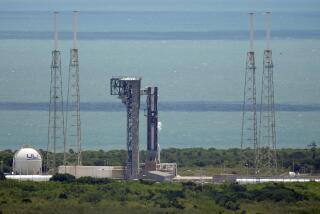Missile Defense System Won’t Be Launched This Year
WASHINGTON — After the Pentagon’s national missile defense system failed a key test this week, the Bush administration has dropped its plans to activate the system by the end of the year.
A spokesman for the military’s U.S. Northern Command said Friday that the missile system would not become operational until early 2005 at the earliest, meaning the Pentagon would miss a goal advanced by President Bush.
The delay in the system followed the failure of an $85-million test Wednesday -- the second major test in two years to fail -- but officials at the Northern Command said the timing of the announcement was unrelated to the failure. Instead, they said a “shakedown” of the system had not been completed.
“The shakedown consists of a series of planned exercises and demonstrations to ensure all system elements -- hardware and software -- are functioning properly and are successfully integrated,” Northern Command officials said in a statement. They said that after the shakedown was completed, commanders would make their recommendations to administration officials to declare the system operational.
The delay marks an embarrassment for the administration after Bush vowed during the presidential campaign to act against the threat of enemy missiles. “We say to tyrants who believe they can blackmail America and the free world, ‘You fire, we’re going to shoot it down,’ ” Bush said Aug. 17 in a campaign speech in Ridley Park, Pa.
Top military officials also have predicted that the system would be operational this year. “By the end of this year we expect to have a limited operational capability against incoming ballistic missiles,” Defense Secretary Donald H. Rumsfeld said in an August address in Huntsville, Ala.
In June, Lt. Gen. Ronald Kadish, then-head of the Pentagon’s Missile Defense Agency, said: “In calendar year 2004, there will be a [missile defense] system in place that will defend the United States. We will have the capability in September [2004].”
This week’s $85-million failed test occurred because the “kill vehicle” that was supposed to come close enough to destroy a mock ballistic missile never left its silo. A safety sensor detected an unknown anomaly and shut the interceptor rocket down seconds before it was to launch from the Ronald Reagan Test Site at Kwajalein Atoll in the central Pacific Ocean.
The missile interceptor is intended to be part of a multilayered system meant to protect the nation from missile attack.
Critics said a declaration that the limited system was operational would not have been credible after the failed test this week.
“I never understood how they could declare operational capability” by year-end, said Philip Coyle, former chief of testing for the Pentagon, who has criticized the administration’s missile defense strategy. “Even if this latest test had been a success -- which it wasn’t -- the Missile Defense Agency itself knows that the system has no capability to shoot down enemy missiles under realistic conditions.”
The system by some accounts has cost $130 billion and is scheduled to require $50 billion more over the next five years. Much of the design work on the interceptor has been done in California.
As envisioned, the system -- promoted by some supporters as an answer to the threat of a missile attack from North Korea -- would rely on interceptors based at Vandenburg Air Force Base and Ft. Greely, Alaska.
More to Read
Sign up for Essential California
The most important California stories and recommendations in your inbox every morning.
You may occasionally receive promotional content from the Los Angeles Times.










